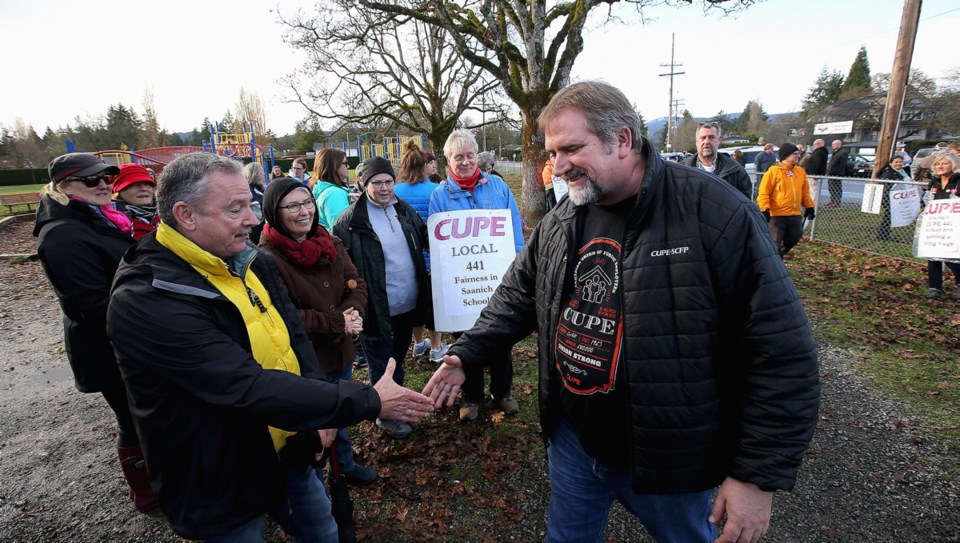Update: Schools in the Saanich School District will be open Monday, after the union reached a tentative deal with the district around noon Saturday.
Neither side is discussing any details on the agreement until union members meet to see the deal in a ratification meeting, likely happening on Sunday.
Dean Coates, president of Canadian Union of Public Employees Local 441, said the tentative agreement falls within the provincial mandate that limits public sector wages increases to two percent annually over three years.
District superintendent Dave Eberwein said the district is “extremely pleased” they’ve reached a tentative agreement.
“We are cautiously optimistic that we will have a deal that will be ratified,” he said.
Regardless of the results of the union members’ vote on the agreement, schools will be open Monday.
Nearly 8,000 students in schools across Saanich, Central Saanich, North Saanich and Sidney have been out of school for three weeks since support workers launched job action on Oct. 28. The union, representing roughly 500 support workers — including education assistants, custodians, bus drivers, administrative staff and more — was seeking wage parity with neighbouring districts. Coates has said the difference in salary, up to several dollars an hour for some roles, had made it difficult to recruit and retain staff, leading to chronically short-handed schools.
— Roxanne Egan-Elliott
- - -
There is talk of a contract settlement in the three-week strike of Saanich School District support workers.
The workers are members of the Canadian Union of Public Employees Local 441. A post on CUPE 441’s Facebook page on Friday night said that the bargaining committee has a meeting set for today. “Please stay tuned for the next email as we are hoping it will be for ratification of our contract,” the post said.
CUPE 441 president Dean Coates was tight-lipped Friday night, but indicated something positive could be happening. “Cautious optimism seems to be paying off,” he said.
Members of CUPE 441 include education assistants, counsellors and custodians. Their main issue is wage parity with counterparts in neighbouring school districts.
Saanich school board vice-chairwoman Elsie McMurphy said the employer’s side is waiting to hear from CUPE 441. “We’re just kind of standing by with our fingers crossed.”
She said the strike has affected a lot of people who are eager for an agreement. “Maybe we’ve got there this time. We’ll see. I think there’s just a collective will to try to bring this to an end.”
The Saanich district is home to nearly 8,000 students, including a group of Grade 12s who staged a Wednesday rally at Education Minister Rob Fleming’s constituency office to air their concerns about keeping up in their courses and preparing for graduation as the strike wears on.
The Saanich Teachers’ Association, which has not been crossing CUPE 441’s picket lines, followed with a rally of its own on Friday at Fleming’s office. The teachers also demonstrated Thursday at the constituency office of Saanich South MLA Lana Popham, with association president Don Peterson calling for her to speak out in support of the strikers.
CUPE national president Mark Hancock, CUPE B.C. secretary-treasurer Trevor Davies and B.C. Federation of Labour president Laird Cronk joined picketers Friday at Brentwood Elementary School.
Coates said CUPE 441’s issue with lower pay is linked to a contract many years ago that featured improved benefits rather than a wage hike. Coates said any gains made from that past contract have been eclipsed.
“Quite frankly, all that’s ancient history with the benefits.”
He said part of that stems from the creation of a standardized benefits package that increased what some other locals were getting.



